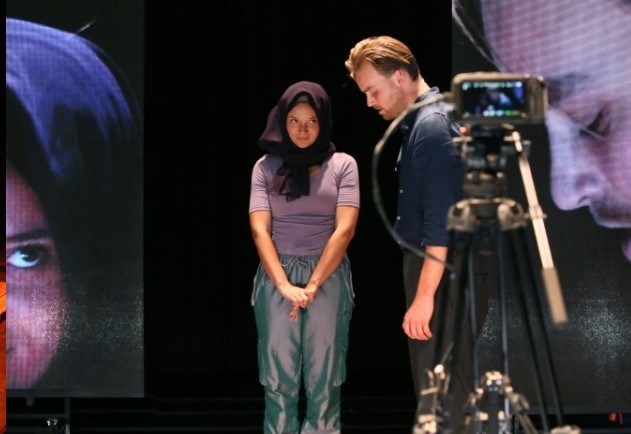 Image from Laura H. promotional page. |
Fast forward five years, and Laura, who returned home in 2016, is Holland's newest superstar, the subject of a bestselling book and now a play, currently being performed to wide acclaim as it tours across the country.
That a journalist penned a 500-page tome about Laura Hansen, and that a 500-page book became a national bestseller, is of course laudable. It speaks of storytelling talent, of intensive journalistic research, and of the deep curiosity of the readers.
But the play is something else. It isn't a portrait of author Thomas Rueb's hunt for Laura's story (think "All the President's Men"). It is not a coming of age story about a young girl (think "Mystic Pizza"). It is the elevation of a Muslim radical, a member of a terrorist group, to rock star status. It is the epitome of the very trend counterterrorism expert Raffaello Pantucci warned us all about, the making of "jihadi cool." And it is unacceptable.
Much of Laura Hansen's life parallels the lives of other radicals – Islamist, white supremacist, and others: a narcissistic search for acclaim and importance, coupled with resentment and a tendency to blame others for one's own mistakes and misgivings. It is a life history frequently darkened and yet energized by tragedy and drama. For Laura, who converted to Islam at 17, there were the boys she slept with – dozens of them – in junior high school. There was the daughter born when Laura was just 16. There was the pregnancy (from a different man) five months later, followed by the abortion, at the urging and begging of the boyfriend who abandoned her anyway that same night.
But all of it, in Laura's view, was always someone else's fault. After all, she thought during her second pregnancy, it said on the Internet that it was almost impossible to get pregnant so soon after giving birth. And she only got the abortion because everyone else, including her parents and her grandmother, wanted her to. Now look what they made her do.
Equally, at least in Laura Hansen's eyes, her promiscuity was not her own doing. It was the fault of her mother and her younger brother, who had the audacity to suffer kidney failure and so, steal all her mother's attention. And attention, for Laura and for other terrorists, is a prime motivator. It is that very lust for power, for stardom, the same hunger for fame and recognition, that drives the terrorist the most, that inspires some Palestinian boys, for instance, to become suicide bombers. As Associate Director of the RAND Homeland Security Research Division Henry H. Willis has written, "One factor presumed to increase terrorists' motivation for attacking is their ability to contribute to a larger cause and the attendant fame that comes with it .... Minutes after an attacker's identity is known, his picture and name spread instantly across media and social networks, affirming the contribution the attacker has made to spread terror and advance his adopted cause."
That search for the spotlight and tendency to deflect blame are typical of both narcissists and, accordingly, of many terrorists, who tend to have multiple symptoms of pathological narcissism. And the same impulses were evident in in Laura even as a child. When she was barely 14, a child services officer described her as "a girl who chiefly followed her own plan, and was not pleased when things didn't go the way she wanted.... Further, she was prone to playing the victim role, laying blame for things that happened on others, outside herself. "
And so, not surprisingly, during her 2017 terrorism trial, Hansen in one breath affirmed her desire for acclaim while deflecting blame for any wrongdoings along the way. According to wire reports, the then-22-year-old testified that "she was under the influence of her violent husband ... She wanted to leave the caliphate, but she stayed ... because she was 'confused' and 'wanted to be somebody.'"
When witnesses told the court that Hansen had in fact been eager to make the trip with Ibrahim, her husband, and while Laura had written her father that she had made the trip of her own volition, in court she blamed Ibrahim for it all. The messages to her father, she testified, were written out of fear of her husband, concerned that had she written anything different, he might find the messages and punish her.
Indeed, Laura had reason to fear her husband: his violent beatings throughout their marriage, the ongoing emotional and psychological abuse, had crippled so much of what had been her own strong will.
Nonetheless, her explanations to the court fail to explain another message Laura sent her father in response to a beheading video, according to prosecutors: "these people have to be removed," she wrote him. "Eye for eye, tooth for tooth."
But "Laura H." does not mention these inconsistencies. It rather immortalizes her story exactly as she narrated it to Thomas Rueb as truth. Even if it isn't.
What everyone does agree is true is this: After what she first described as her escape from ISIS, but what lawmakers later learned was a $10,000 payout her father paid for her freedom, Laura and her two children fled ISIS and Ibrahim and made their way to Dutch authorities in Turkey to request repatriation. An agreement was struck: she would serve time in Vught, a former concentration camp that now houses the country's highest-security prison exclusively for terrorists, and stand trial in the Netherlands.
The trial took place in October 2017. Hansen admitted that while she had not taken part in terrorist acts, she was aware that her husband had been trained by Islamic State militia, and was plotting an attack in Europe – possibly in the Netherlands. The court found her guilty of assisting a terrorist operation, and sentenced her to two years in prison, including time served, with 13 months commuted to probation – leaving her free to return home as early as the following day. Since then, she has been largely silent; she is said to have returned to school, and claims to have renounced Islam.
Rueb, as author, tells Laura Hansen's story compellingly, dramatically. The book reads as a page-turner, and a good one. What is not clear is how much of the story is the tale that Laura told, and how much he actually confirmed, how much of Hansen's tales of victimhood and abandonment and survival would be told quite the same way if others in her life were telling them.
Hence we are to believe, based on both the book and the play that it inspired, that Laura Hansen indeed traveled against her will to Syria; that the conversations Rueb reconstructs took place exactly as he writes them, even as he is working entirely from Laura's own memory – or the memory she claims to have. As such, it is unreliable, at best, but that is actually beside the point.
The real point is that a woman who aided and abetted a terrorist is now literally the star of the show. The real point is that she who, like so many others, joined a terrorist group because she "wanted to be somebody" is now "somebody," and for the sole reason that she joined a terrorist group. For others like her, young men and women living complicated and difficult lives seeking attention, admiration, welcoming, fame, the play "Laura H." offers only one message: Forget martyrdom. Join the jihad, and if you get caught, smile sweetly for the public. Then you, too, can be a star. You, too, can "be somebody."
What's more, as a play – a performance on a stage, in a theater, as opposed to a book – "Laura H." goes even further. It brings glamor. It brings allure. It kisses the edge of Hollywood. It offers the very epitome of "jihadi cool."
And something else. The very existence of "Laura H.," of this play about a young Dutch girl growing up, can't but bring to mind another dramatic production about another young girl in the Netherlands: "The Diary of Anne Frank," first staged in 1955 and based, like "Laura H.," on the book that had preceded it. But the comparison feels to me repugnant, even obscene. Yes, both girls grew up in Holland. And yes, both confronted trauma as young, vulnerable teens. But Anne Frank was generous and insightful. Her empathy and optimism filled the pages of her diary in now-immortal words that confirmed her faith, "despite everything," as she said, in all humanity. She was tenacious, she was brave, and she was – above all – innocent. Anne Frank was, in a word, a hero.
Laura H. is not. To make her one, bowing to applause beyond the footlights, is more than just misguided. It is dangerous.
Abigail R. Esman is a freelance writer based in New York and the Netherlands. She is the author of Radical State: How Jihad Is Winning Over Democracy in the West( Praeger, 2010). Her new book, Rage: Narcissism, Patriarchy, and the Culture of Terrorism, was published by Potomac Books in October, 2020. Follow her at @radicalstates.
